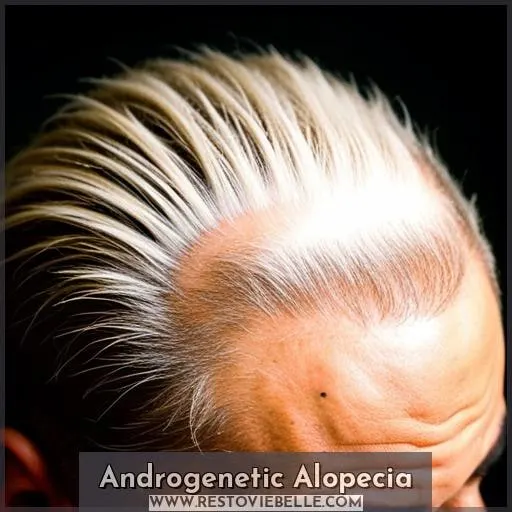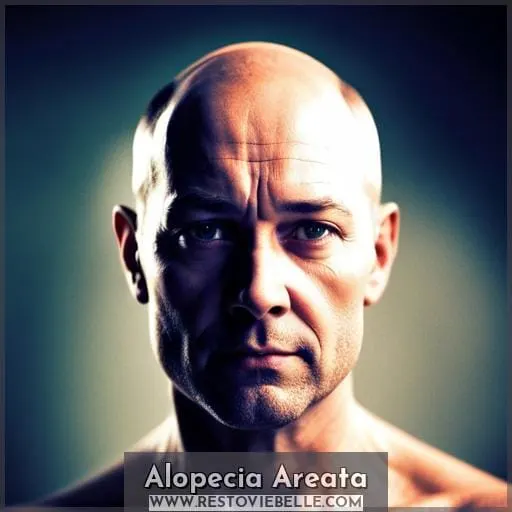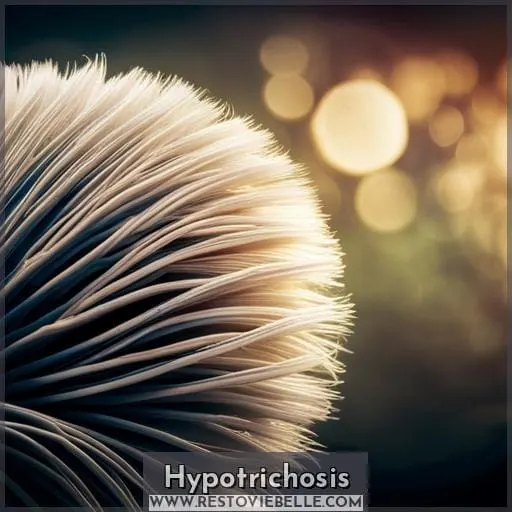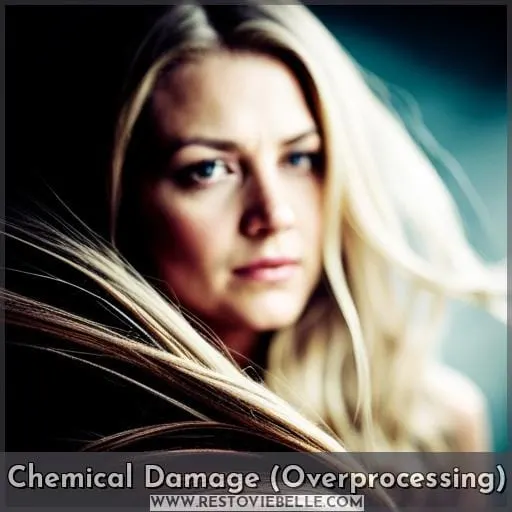This site is supported by our readers. We may earn a commission, at no cost to you, if you purchase through links.
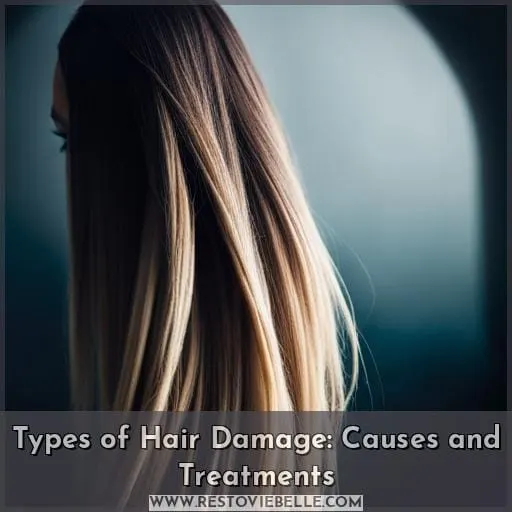
To help restore the health of your locks, it’s important to understand the different types of hair damage and their causes as well as what treatments are available for each type. Let’s take a look at some common types of hair damage including split ends, Androgenetic Alopecia (Male & Female Pattern Hair Loss), Telogen Effluvium, and Anagen Effluvium along with their respective causes and solutions.
With this knowledge in hand, you’ll be able to identify any existing problems with your strands – or those on someone else’s head – so they can get back into tip-top shape!
Table Of Contents
Key Takeaways
- Hair damage can be caused by factors such as sun exposure, chemicals, and heat styling.
- Common types of hair damage include split ends, chemical overprocessing, and mechanical damage from rough handling and tight hairstyles.
- Pattern hair loss can occur in both males and females, with male pattern hair loss resulting in receding hairlines and female pattern hair loss causing slow thinning without noticeable hairline changes.
- There are various hair loss conditions, including telogen effluvium, anagen effluvium, alopecia areata, tinea capitis, cicatricial alopecia, discoid lupus erythematosus, folliculitis decalvans, frontal fibrosing alopecia, hypotrichosis, loose anagen syndrome, trichotillomania, and traction alopecia.
Androgenetic Alopecia
Androgenetic Alopecia, commonly known as male or female pattern baldness, is a hereditary form of hair loss that affects millions. Male Pattern Hair Loss typically starts after puberty and causes the hairline to recede, while Female Pattern Hair Loss results in slow thinning without any noticeable changes to the hairline.
Male Pattern Hair Loss
If you’re experiencing thinning and receding hairline, it could be a sign of Male Pattern Hair Loss. This type of hereditary hair loss is caused by genetic factors that affect the production of hormones, which can lead to baldness progression.
To treat this condition, there are several options, including medications for hormonal influences and topical treatments like minoxidil to stop further hair loss. Additionally, avoiding tight hairstyles or using heat styling tools too often helps in preventing damage.
With proper care and treatment, managing male patterned baldness is possible!
Female Pattern Hair Loss
You may be experiencing Female Pattern Hair Loss, characterized by slow thinning of the hairline without receding.
Treatments for female pattern hair loss include lifestyle changes, medications, and topical treatments that stimulate scalp health and reduce hormonal factors in hair loss. Prevention tips, such as avoiding tight styles like braids or ponytails, are also important to maintain a healthy hair growth cycle.
Additionally, myths about shampooing frequency should be debunked for a better understanding of how to care for your locks! To ensure optimal results, it’s essential to consult with a trichologist who will help you find the best solutions tailored specifically to you so that you can regain your confidence quickly!
Telogen Effluvium
Experience sudden, widespread hair loss as a result of telogen effluvium, a disruption in the resting phase of the hair growth cycle. This type of damage may be caused by managing stress, dietary impact, or hormonal factors.
Common signs are thinning and shedding that doesn’t cause baldness but instead affects your entire scalp.
Treatment options include addressing underlying causes such as lifestyle changes and medications to help manage stress levels. Additionally, using topical solutions like minoxidil can provide an extra boost in regrowth speed.
The recovery process can vary from individual to individual depending on their own unique situation, so it’s important to consult with your doctor for tailored advice and treatment recommendations that best fit your needs specifically.
Taking care of yourself is just as pertinent when it comes to protecting your tresses from any potential damage, whether it’s telogen effluvium or something else entirely.
Anagen Effluvium
Swiftly, Anagen Effluvium can sweep through your hair like a tornado, leaving behind a trail of destruction. It is characterized by rapid shedding and is caused when the anagen phase of the hair growth cycle is disrupted.
This interruption stops new hairs from growing and causes existing strands to fall out prematurely, leading to bald patches and thinning on the scalp or body.
Common culprits for this condition are chemotherapy treatments or certain medications that affect cellular division in follicles. This, in turn, affects their ability to produce healthy hair shafts with normal texture and strength.
Hair styling tools used too frequently or incorrectly can also cause damage, leading to anagen effluvium.
To protect against such damage, it’s best practice not only to use quality products but also to be mindful of how often you use heat-styling tools. Taking other preventive measures, like avoiding tight hairstyles that tug at fragile locks due to excess tension placed on roots, can also help.
Alopecia Areata
Take heart – Alopecia Areata, an autoimmune condition that causes sudden hair loss in patches, can be addressed. With proper care and treatment, it’s possible to stop the progression of this type of hair damage and possibly stimulate new growth.
To start with prevention: identify potential triggers like stress or hormone changes, use protective hairstyles when needed (like scarves or hats), avoid abrasive styling products and tools. Also, regularly apply a nourishing scalp mask for protection against environmental elements.
If you are already experiencing Alopecia Areata-related symptoms such as patchy baldness or thinning on your scalp area, then seeking professional help is recommended for personalized treatments. These treatments may include topical medications that might reduce inflammation while stimulating regrowth, laser therapy to promote circulation around affected areas, and nutritional supplements to boost healthy cell production in order to support hair growth again over time.
Combining these options with gentle yet effective haircare rituals will surely bring positive results towards healthier locks!
Tinea Capitis
Now, let’s take a look at Tinea Capitis. Also known as scalp ringworm, this fungal infection is most common in children and can cause circular patches of hair loss on the scalp.
Scalp infections like tinea capitis are treated with antifungal medications such as ketoconazole or terbinafine taken orally for several weeks to stop the growth of fungi that cause it. Other treatment approaches include topical solutions or creams applied directly to the affected area.
However, these treatments require diligent application over time and aren’t always successful against severe cases of tinea capitis.
To maintain healthy hair and scalps for everyone—especially those under 18—it’s important to practice proper hygiene habits, like regular shampooing. Additionally, using gentle styling techniques, such as loose braids instead of tight ponytails, can help prevent scalp problems.
It’s also crucial to avoid sharing hats, brushes, or combs with others who may have an infection.
A balanced diet that includes protein-rich foods like fish and eggs can contribute to a healthy scalp. If you suspect any kind of scalp problems, it’s advisable to visit your doctor for proper diagnosis and treatment.
Cicatricial Alopecia
Cicatricial Alopecia is a type of hair damage involving inflammation that destroys the follicle and forms scar tissue. It includes several conditions such as Lichen Planopilaris, Discoid Lupus Erythematosus, Folliculitis Decalvans, Dissecting Cellulitis of the Scalp, and Frontal Fibrosing Alopecia.
Each condition has its own distinct symptoms and treatments to help manage them effectively.
Lichen Planopilaris
Discover how Lichen Planopilaris, an inflammatory hair loss condition, causes scarring of the scalp and permanent damage to follicles. It is caused by a malfunction in the immune system that leads to inflammation of the skin and destruction of hair follicles.
Clinical diagnosis involves assessing signs like redness or scaling on affected areas. Treatment options vary depending on severity but can involve topical medications or steroid injections for milder cases; as well as oral immunosuppressants for more severe cases.
Hair care routines with gentle products should be incorporated into treatment plans, while cortex-damaging chemicals such as relaxers should be avoided at all costs! Proper medical attention combined with good haircare habits are key in repairing damaged strands due to lichen planopilaris – ensuring healthy locks again soon!
Discoid Lupus Erythematosus
Unlock the secret of Discoid Lupus Erythematosus – an autoimmune condition manifesting as scaly red patches on the scalp, potentially leading to permanent hair loss.
Symptoms include itching, burning sensations, and areas of baldness caused by inflammation.
Treatment options focus on management strategies for controlling skin manifestations: topical creams or steroid injections to reduce swelling; phototherapy with UVB or PUVA light; and oral medications like hydroxychloroquine.
Protect your scalp from mechanical damage and sun exposure by wearing hats, braids/ponytails loosely tied up in a bun/braid pattern that won’t tug at your roots, using umbrellas for sun protection during peak hours outdoors, and avoiding heat tools if possible when styling hair!
By following these steps, you can protect yourself against Discoid Lupus Erythematosus-related hair damage types.
Folliculitis Decalvans
Feel the devastating effects of Folliculitis Decalvans – an inflammatory condition that causes permanent bald patches on your scalp. The underlying cause is usually a bacterial or fungal infection, with certain factors like a weakened immune system and skin irritation playing an important role.
Treatment approaches include topical and oral antibiotics to manage inflammation, as well as antifungals for more severe cases. Good hygiene practices are essential in preventing recurrences, while managing existing symptoms at home through hydration and low-stress lifestyle habits can help improve outcomes too.
With careful management strategies tailored towards individual needs, regrowth may be possible if caught early enough!
Dissecting Cellulitis of the Scalp
Experience the devastating effects of Dissecting Cellulitis of the Scalp, a type of cicatricial alopecia that can lead to permanent hair loss. Like an athlete whose ligaments have been torn by heavy usage, your scalp may suffer from too much strain and tear.
It’s an inflammatory condition caused by bacterial infection or trauma leading to scarring around hair follicles. Treatment includes identifying underlying causes and choosing effective management approaches such as topical antifungals or antibiotics depending on severity.
With proper scalp treatment, you’ll get rid of any signs of damage like frizzed-out color-treated strands or weakened styling tools-damaged types for good!
Frontal Fibrosing Alopecia
Discover how Frontal Fibrosing Alopecia, a type of cicatricial alopecia, may cause permanent hair loss to the front and sides of your scalp. It’s an autoimmune condition that can affect both men and women. The exact causes are still unknown, but researchers believe tight hairstyles, along with genetic predisposition, could be factors.
Treatments for Frontal Fibrosing Alopecia include topical steroids, minoxidil, immunomodulators, or even surgery in some cases to excise scarred areas on the scalp. To prevent further progression, it’s important not only to treat the existing condition but also to avoid any triggers like tight hairstyles or chemical treatments that could make matters worse over time.
With proper treatment and prevention tips, this form of alopecia can be effectively managed, so you don’t have to worry about losing more hair than necessary due to its progression.
Hair Shaft Abnormalities
Are you experiencing hair loss? It could be due to one of the three common types of hair damage, such as Loose Anagen Syndrome, Trichotillomania, or Traction Alopecia. Understanding what these conditions are and how they affect your scalp can help you determine if any type of medical intervention is necessary.
Loose Anagen Syndrome
You’d be wise to watch out for Loose Anagen Syndrome, a type of hair damage that can cause strands to easily pull free from the scalp. Early detection is key when it comes to preventing long-term damage, like a stitch in time saves nine.
Diagnosis methods involve inspecting the cuticles and running genetic tests if necessary.
Regular haircuts are essential. During the anagen phase, nutrition also helps prevent this condition. Managing childhood hair issues includes using gentle care products and avoiding tight hairstyles or accessories like scrunchies or clips that tug on delicate locks too harshly.
Treatment options vary depending on severity. They range from topical steroid creams and over-the-counter solutions such as minoxidil foam to more extreme measures like platelet-rich plasma therapy (PRP).
Trichotillomania
Feel the irresistible urge to pull out your hair in Trichotillomania, a compulsive disorder that can lead to permanent damage. Hair pulling triggers include emotions, thoughts, or sensations such as stress and boredom.
To manage symptoms, people should seek professional help and use coping strategies like mindfulness meditation and relaxation techniques. Supportive therapies, like cognitive-behavioral therapy, can also help reduce distress related to hair loss from trichotillomania over time.
Long-term effects may include bald patches or cicatricial alopecia due to central centrifugal cicatricial alopecia or traction alopecia caused by chemical damage or hypotrichosis if left untreated for an extended period of time.
Treatments must be tailored according to individual needs for successful long-term management of this condition.
Traction Alopecia
Unbraid your way to healthy hair with Traction Alopecia, a type of damage caused by tight hairstyles. Hairline protection is key. Excess tension can lead to follicle destruction and permanent baldness.
Prevention involves avoiding high-tension styles like braids, ponytails, or buns. It also involves controlling the amount of styling products used on hair strands. Diet plays an important role in recovery too. Eating balanced meals filled with vitamins and minerals help reduce stress levels, which can worsen alopecia symptoms over time.
Hypotrichosis
Discover the devastating effects of Hypotrichosis, a rare genetic condition that results in little to no hair growth and baldness at an early age. This disorder is defined by a lack of melanin production or disruption in the usual hair growth mechanisms.
Genetic factors, like thyroid disorders, can also contribute to this condition, as well as inadequate scalp moisture levels due to poor diet or hygiene practices.
Early intervention strategies are key for slowing down the progression of hypotrichosis, so it’s important to seek medical advice if you suspect your child may have this disorder. Treatment options include hormone therapy, topical solutions, and laser treatments, which help promote healthy new hairs from existing follicles on the scalp while reducing inflammation caused by autoimmune triggers underlying hypotrichosis symptoms.
The psychological impact should not be underestimated either – counseling and support groups can provide much-needed comfort during difficult times associated with any form of alopecia, such as Hypotrichosis.
To prevent further damage, it’s essential that those suffering from Hypotrichosis keep their heads covered when outdoors, use moisturizing shampoo products regularly, and avoid hairstyling techniques (such as braiding) that could disrupt normal catagen/telogen phases, ultimately leading to breakage.
Split Ends
Split ends, the telltale sign of damaged hair, can be difficult to manage – but do you know how to prevent them? Opting for prevention techniques like using silk pillowcases and gentle handling is key.
If split ends have already occurred, try split end-mending serums as a temporary solution or deep conditioners containing natural oils which help repair any damage caused by chemicals and heat styling tools.
Towel drying should be avoided at all costs so as not to cause further breakage when it comes time for disentangling knots – use an old t-shirt instead! Taking care of your locks is paramount if you want strong healthy-looking hair free from dissecting cellulitis or other types of alopecia such as Central Centrifugal Cicatricial Alopecia often caused by excessive heat styling or chemical treatments.
Heat Damage
When it comes to preventing heat damage, the key is to take preventative measures before using styling tools. To protect your hair from frizz and dryness caused by high temperatures, use a product with heat protectant technology like Living Proof NoFrizz Moisture Mask.
You can also reduce the amount of heat you’re using on your hair by reducing temperature settings and avoiding daily blow drying or straightening. When it comes time for styling without damage, opt for air-drying instead of heated tools whenever possible.
This will help preserve natural texture while keeping strands hydrated and healthy looking.
It’s important to remember that each type of hair has different needs when it comes to protecting against heat damage.
Chemical Damage (Overprocessing)
Unleashing harsh chemicals on your hair can cause it to become dry, brittle, and prone to breakage. To avoid chemical overprocessing, use sulfate-free shampoos and conditioning treatments that won’t strip the hair of its natural oils.
Regular deep conditioning with protein-rich masks is a great way to restore resilience in damaged strands while nourishing them at the same time. For extra protection against future damage, opt for strengthening techniques like Olaplex No 3.
Finally, invest in quality products tailored specifically for repairing damaged tresses. These products have been proven effective when used diligently and consistently over time.
Sun Damage
Protect your locks from the sun’s damaging rays by wearing a hat and using UV-filter shampoos. Sun damage can cause hair to become dry, brittle, and prone to breakage. In addition, UVA/UVB exposure can lead to color fading in both natural and dyed hair.
To protect your tresses from the sun:
- Wear hats or scarves when outdoors for extra protection against direct sunlight.
- Use shampoo with built-in UV filters so that it will act as a barrier between your scalp and harmful ultraviolet radiation.
- Avoid using styling tools such as flat irons or curling wands on days when you know there is intense sunshine outside.
Mechanical Damage
It’s time to talk about mechanical damage. This type of hair damage is caused by rough handling and tight hairstyles that create friction, resulting in breakage.
To prevent this from happening, it’s important to be mindful when brushing your hair and opt for protective styles like braids or loose buns instead of tight ponytails or buns. Additionally, try using alternatives to elastic bands such as ribbon ties, which are gentler on the scalp and less likely to cause breakage over time.
Lastly, never tug at your strands while styling. Take care when detangling with a wide-toothed comb or brush instead! With these tips in mind, you can help minimize mechanical damage, keeping your locks strong and healthy all year round!
Hard Water Damage
Hard water can wreak havoc on your mane, causing dryness and breakage that’ll take you back to square one. The effects of hard water are far-reaching; it strips the hair’s natural oils, leaving it brittle and dull.
Fortunately, there are steps you can take to prevent this type of damage from occurring in the first place. First off, use a shower filter or softener. These will remove minerals like calcium and magnesium, which contribute to hard water buildup.
You should also avoid harsh shampoos with sulfates as they strip away vital moisture from strands.
If signs of damage have already set in, then deep treatments such as protein masks may help restore some lost moisture.
Lastly, regular conditioning coupled with gentle handling goes a long way towards keeping those tresses healthy.
Signs of Damaged Hair
Damaged hair isn’t always easy to identify, but there are certain indicators you can look out for. Split ends are one of the most common signs, appearing as frayed and dry-looking strands at the tips of your hair.
Other damage may be harder to diagnose. Try feeling for rough texture or lack of shine in your locks. Sun exposure is another culprit. UV rays weaken and fade your color while also making it brittle over time.
Mechanical damage from brushing too hard or styling with tight braids can cause breakage as well.
Lastly, if you live in an area with hard water, minerals will build up on the surface causing thinning and splitting along strands. But don’t worry! There are several remedies available like a water softener system or chelating shampoo that should help restore balance back into your mane.
Numeric List:
- Hair Damage Indicators: split ends & rough texture
- Repairing Split Ends: trims & serums
- Combating Sun Damage: hats & umbrellas
- Preventing Mechanical Damage: gentle handling
- Hard Water Remedies: softeners & shampoos
Conclusion
It’s estimated that over 80 million Americans suffer from hair loss. However, this isn’t the only type of hair damage. Androgenetic alopecia, telogen effluvium, anagen effluvium, alopecia areata, tinea capitis, cicatricial alopecia, and more are all forms of hair damage that can cause various issues.
Split ends, heat damage, chemical damage, sun damage, mechanical damage, and hard water damage all have their own causes and treatments. Knowing what kind of damage your hair has, and how to treat it, is essential for maintaining healthy, beautiful hair.
Taking preventative measures, such as using heat protectants and deep treatments, can help protect your hair from damage. Paying attention to your hair, minimizing strain, and using protective measures are also key to keeping your hair healthy and looking its best.

